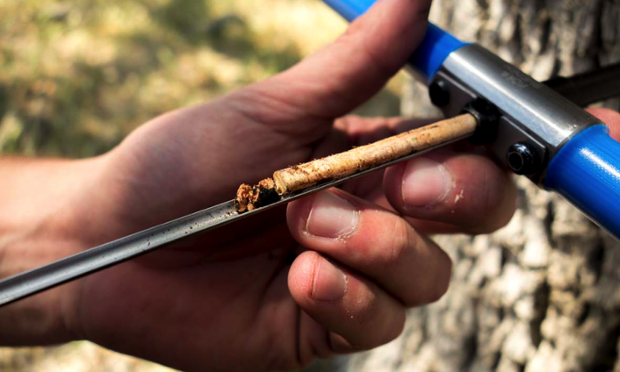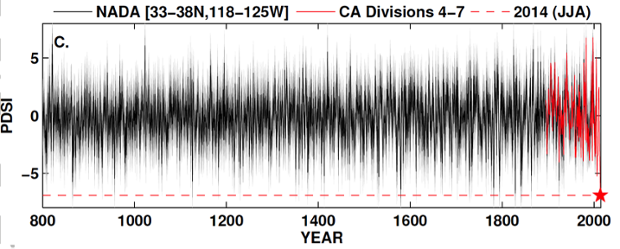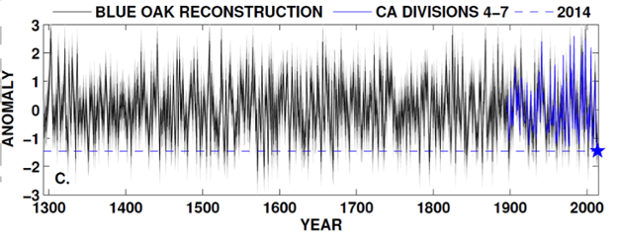California just had its worst drought in over 1200 years, as temperatures and risks rise
Posted on 8 December 2014 by dana1981
A new paper published in the journal Geophysical Research Letters by Griffin & Anchukaitis concludes that the 2012–2014 drought in California was its most intense in at least 1,200 years.
The study used drought reconstructions from tree-ring cores, from the North American Drought Atlas (NADA) and from cores Griffin & Anchukaitis collected from blue oak trees in southern and central California. Blue oak tree ring widths are particularly sensitive to moisture changes. According to Griffin,
California’s old blue oaks are as close to nature’s rain gauges as we get
 Pencil-like tree-ring cores are collected non-destructively using a Swedish increment borer. May 2014, image by Daniel Griffin.
Pencil-like tree-ring cores are collected non-destructively using a Swedish increment borer. May 2014, image by Daniel Griffin.
The study compared today’s drought conditions in California to those reconstructed over the past 1,200 years using the Palmer Drought Severity Index (PDSI), an estimate of available soil moisture. The data showed that California is experiencing its most intense drought in over a millennium,
the current event is the most severe drought in the last 1200 years, with single year (2014) and accumulated moisture deficits worse than any previous continuous span of dry years … In terms of cumulative severity, it is the worst drought on record (-14.55 cumulative PDSI), more extreme than longer (4- to 9-year) droughts.
 Long-term (800 to 2014) composite NADA (black line) and instrumental (solid red line) PDSI. The horizontal dashed red line and star indicate the 2014 value. Photograph: Geophysical Research Letters.
Long-term (800 to 2014) composite NADA (black line) and instrumental (solid red line) PDSI. The horizontal dashed red line and star indicate the 2014 value. Photograph: Geophysical Research Letters.
What’s interesting is that the blue oak data showed that while precipitation levels in California have been low over the past 3 years, the levels haven’t been unprecedented.
 Long-term (1293 to 2014) reconstructed (black line) and instrumental (blue line) normalized precipitation anomalies. The dashed blue line and star indicate the 2014 value. Photograph: Geophysical Research Letters.
Long-term (1293 to 2014) reconstructed (black line) and instrumental (blue line) normalized precipitation anomalies. The dashed blue line and star indicate the 2014 value. Photograph: Geophysical Research Letters.
But at the same time as California has been getting little rain, it’s also experienced record hot temperatures. It’s the heat that’s pushed the drought into unprecedented territory. Griffin & Anchukaitis concluded,
temperature could have exacerbated the 2014 drought by approximately 36% … These observations from the paleoclimate record suggest that high temperatures have combined with the low but not yet exceptional precipitation deficits to create the worst short-term drought of the last millennium for the state of California … Future severe droughts are expected to be in part driven by anthropogenic influences and temperatures outside the range of the last millennium.
Another new paper also published in Geophysical Research Letters by scientists at the University of California, Irvine likewise recognizes the extreme and unprecedented nature of California’s current drought, and focuses on the risks that these events pose in the present and future.
Despite the well-recognized interdependence between temperature and precipitation … little attention has been paid to risk analysis of concurrent extreme droughts and heatwaves … We argue that the global warming and the associated increase in extreme temperatures substantially increase the chance of concurrent droughts and heatwaves.
As the authors note, at issue is the fact that humans are causing temperatures to rise. Thus although droughts will always happen naturally, as studies have shown, they’ll become more intense in a warmer world. The combination of dry, hot weather will create bigger risks for Californians.
The human connection to the California drought
Climate scientist Michael Mann nicely summarized the ways that humans may have contributed to the current California drought,
In fact, there are at least three different mechanisms that are potentially relevant to the connection between the 2013/2014 California drought and human-caused climate change.
There is (1) the impact of climate change on the pattern of sea surface temperature (SST) off the west coast. One recent study suggests that climate change favors an SST pattern in the North Pacific that increases the incidence of the atmospheric circulation pattern responsible for the current drought.
Then there is (2) the marked decrease in Arctic Sea Ice due to global warming. Studies going back more than a decade show that reduced Arctic sea ice may also favor such an atmospheric circulation pattern. More recent work by Jennifer Francis of Rutgers provides independent support for that mechanism.
Finally, there is (3) the effect of global warming on soil moisture. All other things being equal, warming of soils leads to greater rates of evaporation and drying. This mechanism leads to worsened drought even if rainfall patterns are unchanged.
There’s been some confusion about the human influence on the drought because two studies published this year didn’t find a connection to the lack of rainfall. However, as Mann noted, those studies did not consider the three mechanisms listed above. They were incomplete. On the other hand, two other studies that considered the first factor did find a connection.
A high pressure ridge sitting of California’s coast for several years (known as the “Ridiculously Resilient Ridge” for its persistence) has been a primary factor contributing to the low levels of precipitation. The ridge has pushed storms north of California, leaving the state dry. A study led by Noah Diffenbaugh at Stanford used modeling and statistics to find that these sorts of persistent high-pressure ridges are more likely to sit off California’s coast in the presence of high levels of greenhouse gases in the atmosphere.
Another paper published this year by Simon Wang and colleagues similarly concluded that human-caused global warming is changing conditions in the Pacific Ocean that make these high-pressure ridges off the coast stronger, thus intensifying droughts in California.































 Arguments
Arguments






























This report is like so many in climate science in that two opposing explanations are put foward for the same event. Here it is strongly implied that the Californian drought is due to human activities whereas a report from NOAA scientists states it is not (www.usatoday.com/story/weather/2014/12/08/california-drought-cause-noaa/20095869/) Who to believe?
[JH] What you are observing is the scientific process at work. Over time, the seeming contradictions will be sorted out. This sifting and winnowing process occurs in all scientific disciplines. Your suggestion that conflicting explanations are unique to climate science is bogus.
The actual statement in the article is "in fact, there are at least three different mechanisms that are potentially relevant to the connection"
I am not sure that "potentially relevant" is the same as "strongly implied". However, the 3rd mechanism is important. While there have undoubtedly been low rainfall periods in the past from other causes, higher temperatures worsen the intensity of drought ( which is what PDSI attempts to quantity).
It is extremely difficult to link any particular weather event to climate change - in general climate change only affects the probability of a weather event happening and its severity.
As far as I can see, the NOAA study only considers rainfall patterns, and the article above says, it does not consider changes to jetstream (very unsettled science admittedly).
william (who is, may I point out, not the same as me!), your question is directly addressed in the article:
william @1, see wili @3. The NOAA report is flawed in its failure to consider the drought influence from human-caused warming, as I discuss above. The human influence on CA precipitation is a mixed bag, with 2 studies finding no connection and 2 finding a connection. NOAA focused on the former 2 (having authored one of them), but frankly I find the other two (Diffenbaugh and Wang) more convincing.
Nevertheless, there is indisputably a human influence on the drought due to warming. NOAA is doing the public a disservice by claiming otherwise.
Thanks Dana. Yes the comment from Prof Mann mentioned in Will@3 was present in the article I linked to as was a comment by Kevin Trenberth "This study completely fails to consider what climate change is doing to water in California,". As both are well respected climate scientists I guess NOAA will address their comments in due course.
I note you consider "NOAA is doing the public a disservice by claiming otherwise". while the Moderator's opinion is "What you are observing is the scientific process at work. Over time, the seeming contradictions will be sorted out. This sifting and winnowing process occurs in all scientific disciplines". So is the sifting and winnowing a disservice to the public or just a necessary part of the scientific process?
He also berates me for suggesting " that conflicting explanations are unique to climate science is bogus". Actually ` didn't suggest that at all if I had meant to make that suggestion I would have written "in contrast to other branches of science only in climate science are two opposing explanations are put foward for the same event" That would clearly be utterly incorrect.
[JH] You are skating on this thin ice of moderation complaint. Please read and adhere to the SkS Comments Policy.
In the first graph, above, the variability strongly suggests that most of the current drought is natural. However, I was struck by the average value. It indicates that drought became slightly less severe from 800 AD to 1880 AD, after which it abruptly changed its trend, and became rapidly more severe throughout the last century. An abrupt trendline reversal at 1880 AD is also seen in global temperature. Correlation is not causation, but its hard not to ignore the average trendlines of CA PDSI and global temperature, both abruptly changing direction around 1880.
Correlation is not causation, but its hard not to ignore the average trendlines of CA PDSI and global temperature, both abruptly changing direction around 1880.
William,
It seems to me that Dana is arguing that there are two opposing scientific opinions. Dana favors the increasing drought argument. NOAA says the drought is likely natural and fails to mention the opposing opinion. A respected voice like NOAA should mention both sides when there is still active debate. It appears that Mann and Trenberth disagree with NOAA so it is clearly debatable. I agree that NOAA is doing a disservice to the public when they leave out a prominent opinion. If it turns out that the drought is caused by AGW, NOAA has misinformed the public and contributed to a lack of effort to take action.
[JH] A number of prominent climate scientists have expressed their opinions about the NOAA paper to NBC News.
See: Global Warming Isn't Causing California Drought? Report Triggers Storm by Miguel Llamos, Dec 8, 2014.
Perhaps it is the wording that is the problem. The NOAA article argues that there is a pre-existing mechanism which causes drought in CA. It does not argue that global warming is not a factor. It seems valid to show alternative mechanisms. The next task is to show how they fit in and to what extent they may cause exacerbation or reduction in the effects of climate change.
Proponents of the science should show subsequent and consequent mechanisms etc. It probably will happen in the peer review process which has not occurred for this paper yet.
I think wording does have a lot to do with it. NOAA is pointing out there is no trend in rainfall. Availability of water for plants is what to a fair extent defines drought. This is what PDSI and the tree-derived proxies reflect. Rainfall by itself is not as informative.
scaddenp @9 is correct. The problem with the NOAA report is that it's not a drought report, it's a rainfall report. There's more to drought than just precipitation, with temperatures being another significant factor.
Humans may or may not have influenced the Ridiculously Resilient Ridge and hence the low precipitation indicated in the second figure above. I think NOAA is being overconfident in saying there's no human connection, but we can't yet say for sure either way.
However, humans indisputably played a role in the severity of the drought via global warming and higher temps. This causes soil dryness, higher demand, decreasing snowpack, etc. etc. For NOAA to ignore these influences and make claims about "drought" is misleading. Unintentionally so - they're just defining "drought" in a very limited (and IMO kind of dumb) way, but misleading nonetheless.